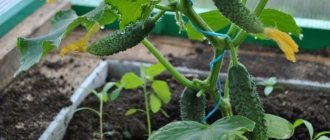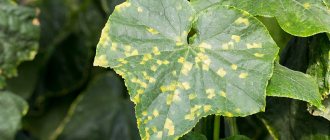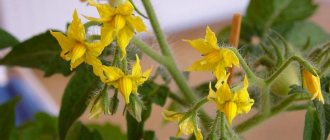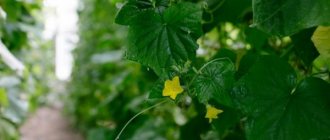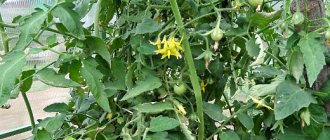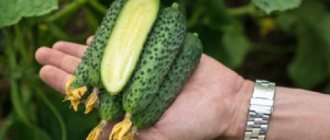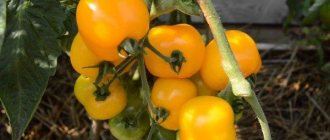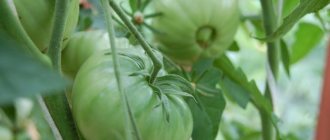Do cucumbers need to be pollinated?
Many vegetable growers who have not previously grown cucumbers in a greenhouse are wondering whether they need to be pollinated.
The answer to this question depends on the characteristics of the variety being grown. Hybrid cucumbers that do not require pollination are called parthenocarpic. The advantages of such plants include the fact that cucumber fruits form and ripen without pollination. Therefore, when planting such self-pollinating hybrids, gardeners will not have to waste time on artificial fertilization of cucumbers.
However, most often people plant bee-pollinated varieties of vegetables that do not begin to bear fruit without pollination. Experienced gardeners advise planting them outside so that the bees can pollinate the flowers. If such cucumbers were planted in a greenhouse, you will have to deal with the transfer of pollen yourself.
What varieties of cucumbers need pollination?
There are several common cucumber varieties that require pollination:
- Martin. An early-ripening bee-pollinated cucumber intended for planting in a greenhouse. The Swallow harvest manages to ripen 40-50 days after the appearance of young shoots. Ripe cucumbers are compact and are used for pickling.
- ABC. A high-yielding plant with resistance to many diseases and parasites. The main advantage of ABC is considered to be the taste of the crop, which does not have a bitter aftertaste.
- Lord. A mid-season hybrid vegetable that can be grown in both closed and open beds. Lord has good immunity, which protects seedlings from fungal infections and sudden temperature fluctuations. The length of the fruit reaches 15 centimeters, and the weight is 200-250 grams.
- Teremok. A productive vegetable, the bushes of which are dominated by female flowers. Ripe cucumbers are medium in size and grow up to ten centimeters. The mass of Teremok fruits does not exceed 180 grams.
- Acorn. A bee-pollinated hybrid with low bushes and low yield. Acorn greens weigh 120-130 grams and their length is 7-8 centimeters.
See also
Characteristics of cucumbers Hit of the F1 season, growing features and yield
Read
We create comfortable conditions
All manipulations are carried out at an average humidity level of about 70-75%. If the indicator is below 60%, you should abandon the procedure, otherwise the pollen will dry out. Do the same at humidity levels above 80%. Other recommendations:
- female flowers are ready for pollination on the 2nd day;
- during varietal pollination, the inflorescences are covered to prevent insects from getting there;
- self-pollinating flowers are marked so as not to be confused;
- the optimal temperature background for pollination is +20 C + 25 C;
- Repeating pollination daily for a week will help increase the chances of success;
- the collected pollen is transferred to a bush that grows nearby, but not to the same one.
The main differences between male and female flowering types
Before artificially pollinating vegetables, it is necessary to understand the main differences between female and male flowers.
Locations
You can distinguish male and female flowers by their location. Most often, male flowers are located in the lower part of the bushes.
Appearance
Experienced gardeners recommend paying attention to their appearance to distinguish different types of flowers. Female flowers have small stamens, which are located on one of the side shoots. Outwardly, they look like a small seal that resembles a ripe cucumber.
Inside male flowers, instead of pistils, there is a pollinator, which is needed for pollination. If you gently shake the plant, a small pollen cloud will form near the male barren flower.
Optimal conditions for fruitful pollination
Pollination should be carried out under optimal conditions:
- Humidity level. The success of the procedure depends on air humidity. Vegetable growers advise pollinating cucumbers when the humidity level does not exceed 70-75%. When humidity is high, pollen quickly sticks together, and when humidity is low, it dries out.
- Temperature values. Temperature is also of great importance. Pollen activity begins to decrease when temperatures reach thirty degrees Celsius. Pollination cannot be carried out if the temperature in the greenhouse or outside drops below 10 degrees. Indicators in the region of 15-25 degrees above zero are considered optimal.
- Time spending. Gardeners advise pollinating seedlings in the morning, until 11-12 noon.
- Pest protection. All pollinated inflorescences must be covered with small pieces of fabric. This is done to protect them from pests.
- Lighting. Some people believe that light levels have no effect on pollination, but this is not true. It is necessary to ensure that the plant is well lit in advance. If it is grown in a greenhouse, LED lamps can be used as additional lighting.
How to pollinate tomatoes by hand?
The tomato is a facultative self-pollinator, which means that each of its flowers has both male and female reproductive organs, and pollen ripened in the stamens can end up on the pistil of someone else’s flower or its own flower. If this happens, then within 12-36 hours the pollen grain caught on the stigma of the pistil will reach the ovule of the ovary, after which an ovary will form on the flower.
Under favorable conditions, the process of fertilization of tomatoes occurs on its own and does not require third-party intervention. If you notice that the tomatoes growing in your greenhouse are a little late and are not in a hurry to form ovaries, try a few simple methods.
- Maintain greenhouse temperatures between 20-25°C, as temperatures that are too high (>30-32°C) will negatively affect pollen quality. To reduce the temperature in the greenhouse, shade the plants by placing a white covering material under the top of the greenhouse; observe the ventilation mode and place several containers with water in the greenhouse so that they “take away” the heat.
- Ensure the humidity in the greenhouse is no higher than 70%, otherwise the pollen will roll into lumps and fall off. To prevent this from happening, follow a schedule for watering your tomatoes and, if possible, mulch the ground under the bushes.
- To stimulate the formation of ovaries, spray the plants with a solution of boric acid (2.5 g per 10 liters of water) every 10-14 days. You only need to spray those leaves that have formed over the past two weeks.
- Do not let the plants grow excess green mass - do not forget about the formation of the bush and the timely removal of stepsons.
- How to properly pick tomatoes and whether you need to do it at all
Why shoot tomatoes, how to do it correctly and what will happen to the tomatoes if you don’t do shoots? Let's figure it out together!
In order to manually pollinate tomatoes growing in a greenhouse, it is enough to lightly shake the flower brushes twice a day (morning and evening). If you're growing tomatoes in small quantities, you can gently transfer pollen from one flower to another using a paint brush.
What is artificial pollination of cucumbers?
Before you start pollinating cucumbers yourself, you need to become more familiar with this process.
Artificial pollination is the transfer of pollen from one flower to another. If the plant is grown outdoors, this procedure is performed naturally with the help of water, insects or wind. When bushes are grown indoors on a balcony or greenhouse, you will have to pollinate the vegetables yourself.
This is a labor-intensive process for which you need to carefully prepare. It is necessary to determine in advance the timing of the procedure and figure out how to do everything correctly.
Pollination of cucumbers in a greenhouse by insects
lure bees into the greenhouse by spraying the bushes with a specially prepared solution. To do this, take 1 liter of water (not cold), 1 tbsp. l. honey or jam, which has been candied and 0.1 g of boric acid.
Advice. When processing bushes, do not forget to provide bees with access to flowers: open windows and doors. Naturally, do this not to the detriment of the internal microclimate, avoiding violation of the temperature regime.
Place a bee colony in the greenhouse. If you grow cucumbers starting in late winter, do it in early spring. Initially, you need to let the insects into an empty greenhouse. Naturally, it must be heated. Closer to the onset of warmth and flowering of plants, place the hive at a height of about 40 cm at the side wall of the greenhouse, across the walkway.
Natural pollination of cucumber
The place needs good morning lighting. The glass that is located at the back of the hive should be darkened, for example, with a sheet of plywood. When the honey plants begin to bloom, the bees should fly out of the greenhouse. To do this, make a window in the roof, whitening the glass around it with chalk. This way the insects will be better able to navigate.
With the onset of heat, it is necessary to make a round hole in the wall of the greenhouse. Place the hive on the outside close to the greenhouse. The window in the wall and the entrance to the hive must coincide. Now some bees will pollinate cucumber flowers, and some will fly outside to collect pollen from honey plants.
Manual pollination technology for cucumbers
There are two main technologies with which cucumbers can be pollinated. It is recommended that you familiarize yourself with their main features in advance in order to understand how to use them in practice.
See also
Description of the Claudine cucumber and recommendations for growing the hybrid
Read
Pollination by flower
Gardeners who decide to pollinate cucumbers themselves use a male flower for this. First, it is carefully plucked from the bush, after which all its petals are torn off. Then you need to gently touch the stamens with your palm so that pollen remains on its surface. After this, the palm touches the pestles.
To ensure that the plant is accurately pollinated, you can shake the plucked male flower near the female one. All pollinated flowers must be marked with a marker.
Pollination by brush
The most common method of transferring pollen from flowers that have begun to bloom. It is recommended to use brushes with natural and soft bristles that will not damage the flowers.
When performing the procedure, pollen is carefully collected from the flower. In this case, you need to make sure that it settles on the bristles of the brush. The collected pollinator is then carefully transferred to the female pistil.
Pollination conditions
Tomatoes are self-pollinating plants. This means that the pollen from their flowers is suitable both for pollinating themselves and other plantings.
However, growing crops in greenhouse conditions means year-round pollination, when there are simply no insects. In this case, pollination of tomatoes in the greenhouse occurs using other methods. They can be used in summer, as a complement to “natural” ones.
Pollination is a mandatory procedure, without which the formation of ovaries is impossible. Technically, the task boils down to ensuring that pollen reaches the stigma of the pistil. But the result largely depends on the quality of the pollen itself. It can be used both for self-pollination and for pollinating neighboring bushes.
Artificial pollination of tomato.
The results are also affected by the temperature and humidity conditions in which the tomatoes grow. When growing in open ground, ideal conditions cannot be achieved, so the greenhouse option is an advantage.
The temperature should not fall below 13 degrees and be above 30. At lower temperatures, the anthers in the flower are deformed, which prevents the penetration of pollen. If the temperature exceeds 30-35 degrees, the pollen is sterilized and fertilization becomes impossible. It is necessary to remember that during the flowering period, even a short-term violation of the temperature regime can lead to complete fall of flowers and loss of harvest.
Another important factor affecting pollen quality is air humidity. When the humidity is more than 70%, the pollen sticks together and cannot, firstly, scatter over a sufficiently large distance, and secondly, this complicates its interaction with the anther of the flower. However, too dry air is not good for pollen.
Thus, to ensure ideal conditions, the gardener needs to put a lot of effort. This can be achieved, for example, by building a good ventilation system in the greenhouse. A good option would be to install an automatic or manual window.
Return to contents
How to pollinate cucumbers in a greenhouse without bees?
In some greenhouses, not a single bee can penetrate and because of this, the cucumbers will have to be pollinated by hand.
There are several recommendations that you should familiarize yourself with before transferring pollen:
- Experts advise carrying out the procedure early in the morning, before the sun begins to dry out the air. If the weather is cloudy outside, you can do everything later.
- It is recommended to pollinate when the air humidity level does not exceed 70%, so that the pollen does not stick together and form large clumps.
- Cucumbers grown on a windowsill or in a greenhouse are pollinated two days after the flowers bloom. The result will be noticeable within 3-4 days. The size of the ovary in fertilized plants will begin to increase rapidly.
- All fertilized bushes must be marked. This is done so as not to re-fertilize already pollinated cucumber seedlings. You can mark the bushes with a marker, gouache or watercolor paint.
- After pollination, all plants are carefully examined. If their ovaries do not begin to enlarge, then pollination will have to be repeated.
How to pollinate cucumbers at home
By growing cucumbers in the winter on a window, insulated balcony or loggia, you can provide yourself with vitamins without spending much money and get sincere pleasure from the process itself.
Is it possible to grow cucumbers at home?
Many enthusiastic summer residents cannot resist growing not only green onions and parsley, but also fresh cucumbers at home in the winter. In fact, this is not at all difficult; all you need to do is choose the appropriate variety or hybrid of cucumbers. You can plant cucumbers for growing in a window starting in mid-January, but be sure to use lighting for 10-12 hours a day. To sow, cucumber seeds need to be soaked for several hours for better germination. Prepare pots for sowing with a diameter of at least 15 cm. Since cucumbers do not tolerate transplantation very well, they must be immediately planted in a permanent place. Cucumber seedlings are demanding of light; when there is insufficient lighting, they stretch out, turn pale, become weak and do not gain color for a long time. You shouldn’t expect a good harvest from them, so take care of additional lighting in advance: place a lamp with a fluorescent lamp over the seedlings and ensure daylight hours for 10-12 hours. Your pets will thank you with rapid growth, active flowering and fruiting. In order to support the stretching lashes, consider and make trellises. After the appearance of the third true leaf, the plant needs to be pinched, this will speed up the appearance of female flowers and the beginning of fruiting. Don't forget about fertilizing - for this, universal mineral fertilizer is used twice, with a break of a month.
How to pollinate cucumbers growing at home
Parthenocarpic cucumber hybrids are more suitable than other varieties for growing on a window, balcony or loggia, i.e. not requiring pollination. These include “Zozulya”, “Aprilsky”, “Manul”. These hybrids differ from ordinary varieties in the large number of female flowers, from which, after flourishing, a cucumber begins to develop. They are also quite resistant to changes in ambient temperature. However, bee-pollinated varieties can also be grown at home, although this will require more time and attention to your pets. For growing at home, parthenocarpic self-pollinating hybrids that are resistant to unfavorable conditions are used. In order to artificially pollinate cucumbers, you need to carefully observe the flowering: you must learn to distinguish male flowers (barren flowers) from female ones. The female ovaries are visible to the naked eye: the flower blooms on a small green seal, shaped like a cucumber. Your task is to transfer pollen from the male flower to the female flower and pollinate it. Pick the barren flower, tear off the petals so that the stamen is exposed. Then touch it to the pistil in the female ovary. To be sure, repeat the action several times, but carefully, do not break off the ovary. If pollination was successful, the ovary will begin to increase in size; if pollination does not occur, it will fall off. It is best to carry out pollination in the morning.
KakProsto.ru
Not all gardeners who decide to grow this healthy and nutritious vegetable all year round know how to pollinate tomatoes in a greenhouse. Productivity depends on the quality and quantity of pollination. If you simply plant the seedlings in well-prepared soil and provide the proper conditions for temperature and humidity, then you should not be surprised at the complete absence of a harvest. Tomatoes can be grown both in open ground and in a greenhouse. Both methods are good in their own way and have a number of features. In particular, when growing outdoors, there is no problem of pollination: nature does everything itself. Wind, butterflies, bees and other insects spread pollen without any intervention from the gardener, and the plants are pollinated.
Tomato pollination is carried out using natural and artificial methods.
Insects are rare in the greenhouse, and this makes pollination really problematic. In warm summer weather, the greenhouse does not close almost 24 hours a day. Insects can fly in and out of it freely. And the gardener is faced with the task of attracting insects inside the greenhouse.

